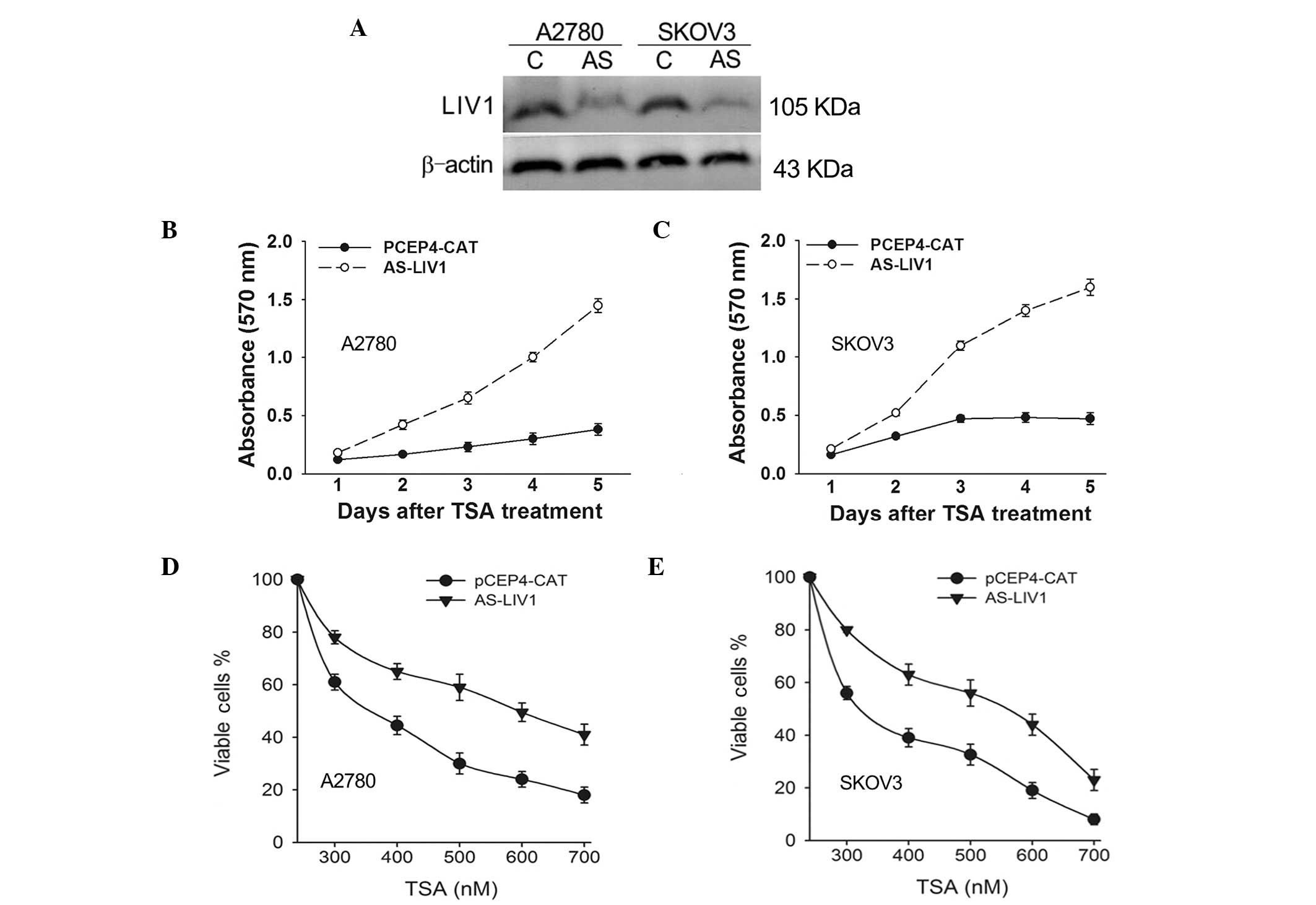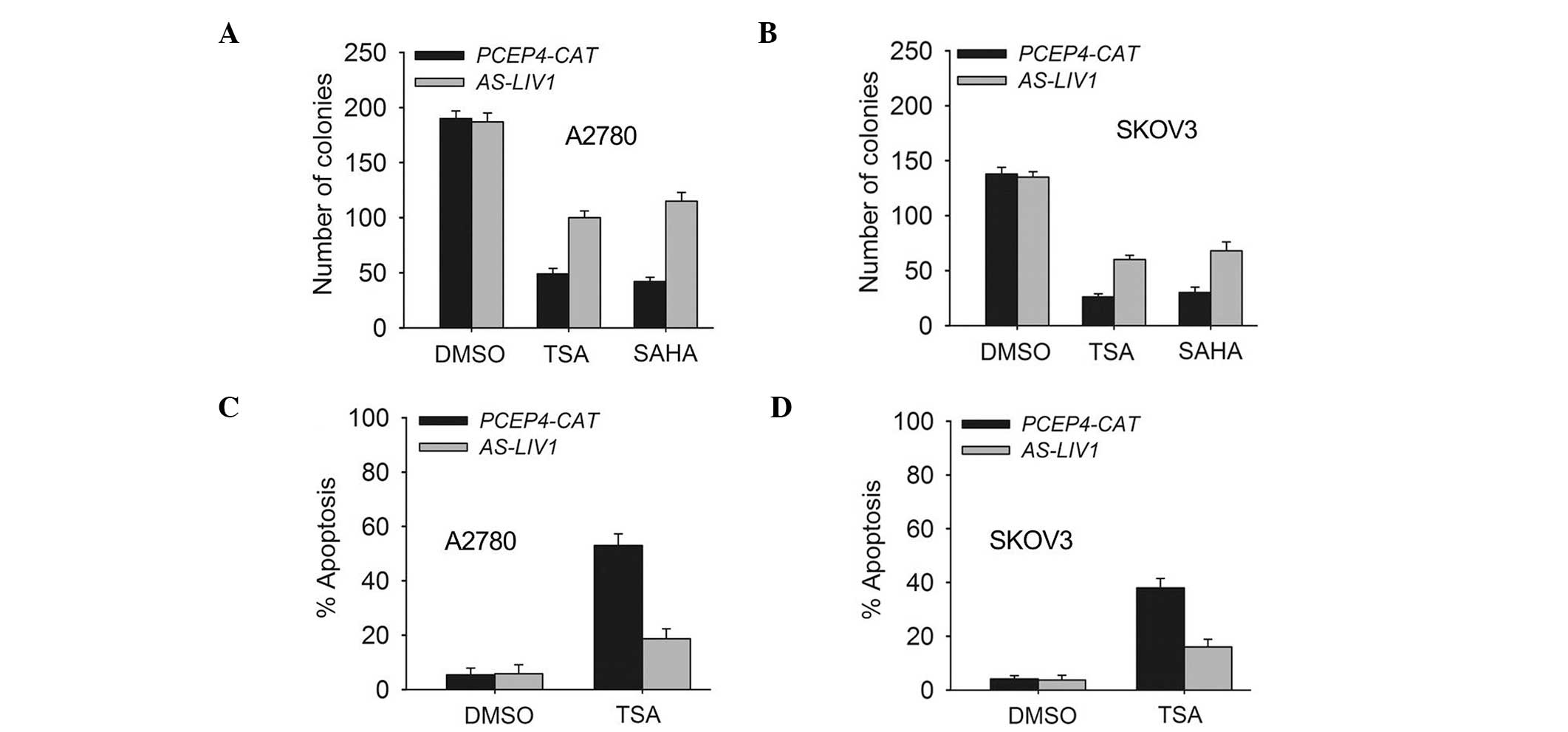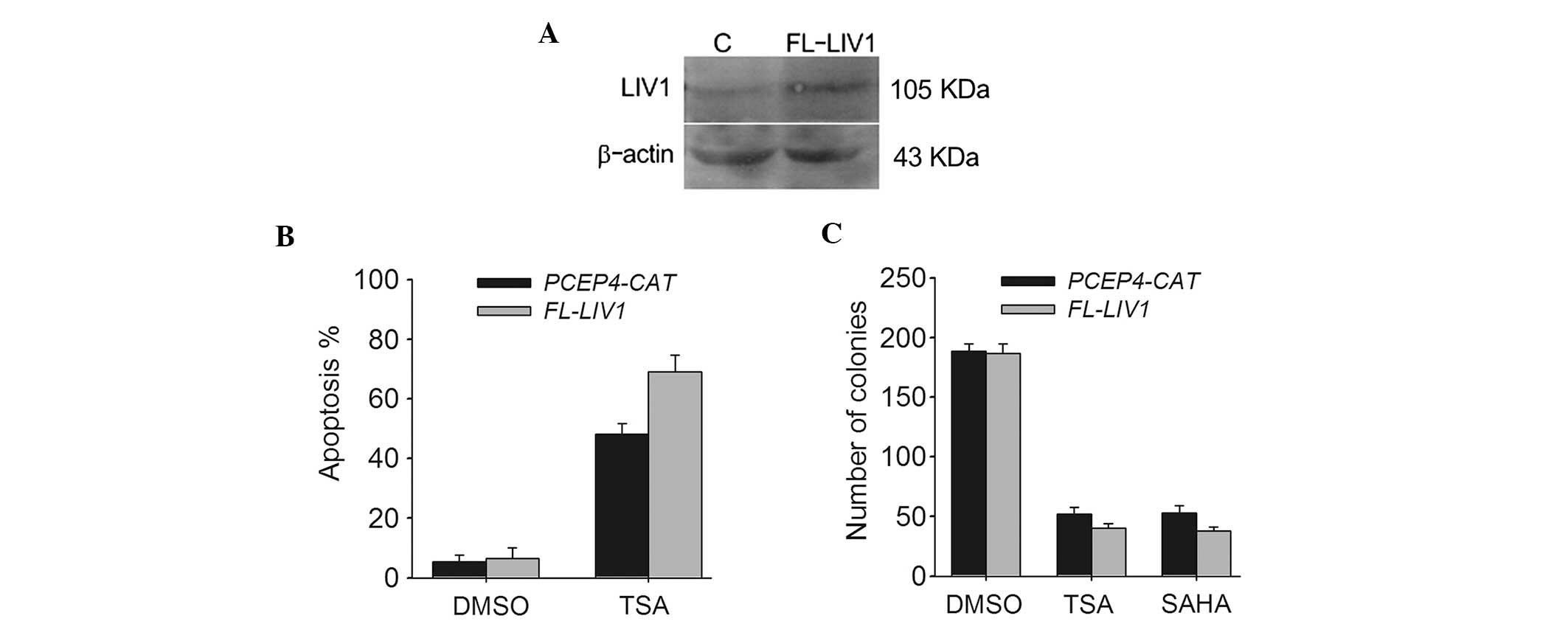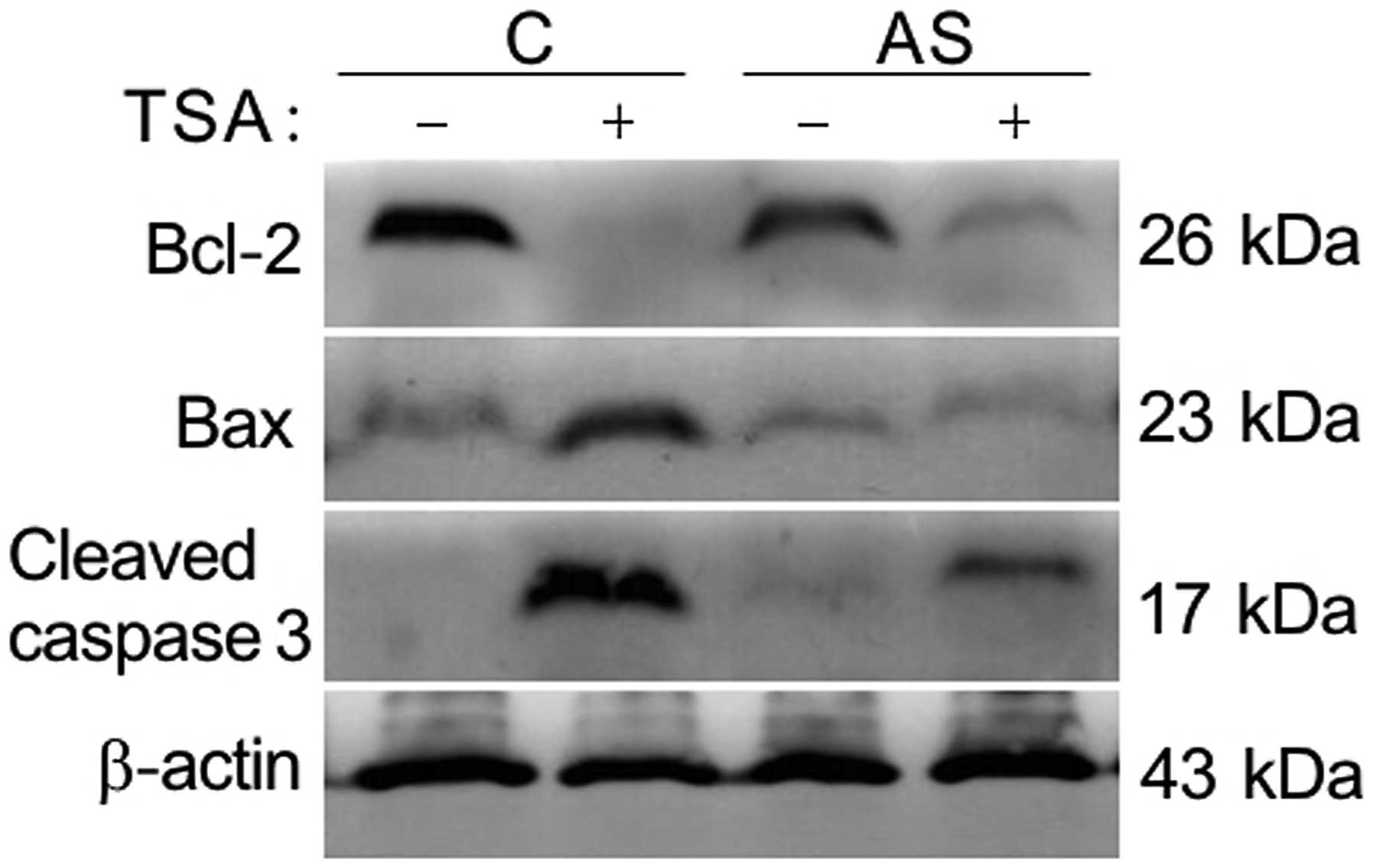|
1
|
Jemal A, Bray F, Center MM, et al: Global
cancer statistics. CA Cancer J Clin. 61:69–90. 2011. View Article : Google Scholar : PubMed/NCBI
|
|
2
|
Hennessy BT, Coleman RL and Markman M:
Ovarian cancer. Lancet. 374:1371–1382. 2009. View Article : Google Scholar : PubMed/NCBI
|
|
3
|
Zahedi P, Yoganathan R, Piquette-Miller M
and Allen C: Recent advances in drug delivery strategies for
treatment of ovarian cancer. Expert Opin Drug Deliv. 9:567–583.
2012. View Article : Google Scholar : PubMed/NCBI
|
|
4
|
Vecchione A, Belletti B, Lovat F, et al: A
microRNA signature defines chemoresistance in ovarian cancer
through modulation of angiogenesis. Proc Natl Acad Sci USA.
110:9845–9850. 2013. View Article : Google Scholar : PubMed/NCBI
|
|
5
|
West AC and Johnstone RW: New and emerging
HDAC inhibitors for cancer treatment. J Clin Invest. 2:30–39. 2014.
View Article : Google Scholar
|
|
6
|
Slingerland M, Guchelaar HJ and Gelderblom
H: Histone deacetylase inhibitors: an overview of the clinical
studies in solid tumors. Anticancer Drugs. 25:140–149. 2014.
View Article : Google Scholar
|
|
7
|
Højfeldt JW, Agger K and Helin K: Histone
lysine demethylases as targets for anticancer therapy. Nat Rev Drug
Discov. 12:917–930. 2013. View
Article : Google Scholar : PubMed/NCBI
|
|
8
|
Marchion D and Munster P: Development of
histone deacetylase inhibitors for cancer treatment. Expert Rev
Anticancer Ther. 7:583–598. 2007. View Article : Google Scholar : PubMed/NCBI
|
|
9
|
Marks PA and Breslow R: Dimethyl sulfoxide
to vorinostat: development of this histone deacetylase inhibitor as
an anticancer drug. Nat Biotechnol. 25:84–90. 2007. View Article : Google Scholar : PubMed/NCBI
|
|
10
|
Rasheed WK, Johnstone RW and Prince HM:
Histone deacetylase inhibitors in cancer therapy. Expert Opin
Investig Drugs. 16:659–678. 2007. View Article : Google Scholar : PubMed/NCBI
|
|
11
|
Fakih MG, Pendyala L, Fetterly G, et al: A
phase I, pharmacokinetic and pharmacodynamic study on vorinostat in
combination with 5-fluorouracil, leucovorin, and oxaliplatin in
patients with refractory colorectal cancer. Clin Cancer Res.
15:3189–3195. 2009. View Article : Google Scholar : PubMed/NCBI
|
|
12
|
Ma XL, Ma QF, Liu J, et al: Identification
of LIV1, a putative zinc transporter gene responsible for
HDACi-induced apoptosis, using a functional gene screen approach.
Mol Cancer Ther. 8:3108–3116. 2009. View Article : Google Scholar : PubMed/NCBI
|
|
13
|
Yamashita S, Miyagi C, Fukada T, et al:
Zinc transporter LIV-1 controls epithelial-mesenchymal transition
in zebrafish gastrula organizer. Nature. 429:298–302. 2004.
View Article : Google Scholar : PubMed/NCBI
|
|
14
|
Kasper G, Weiser AA, Rump A, et al:
Expression levels of the putative zinc transporter LIV-1 are
associated with a better outcome of breast cancer patients. Int J
Cancer. 117:961–973. 2005. View Article : Google Scholar : PubMed/NCBI
|
|
15
|
Ma XL, Liu J, Wu J, et al: Synergistic
killing effect between vorinostat and target of CD146 in malignant
cells. Clin Cancer Res. 16:5165–5176. 2010. View Article : Google Scholar : PubMed/NCBI
|
|
16
|
Sankavaram K, Chong L, Bruno RS and Freake
HC: Zinc status alters growth and oxidative stress responses in rat
hepatoma cells. Nutr Cancer. 66:104–116. 2014. View Article : Google Scholar
|
|
17
|
Nygaard SB, Larsen A, Knuhtsen A, et al:
Effects of zinc supplementation and zinc chelation on in vitro
β-cell function in INS-1E cells. BMC Res Notes. 7:842014.
View Article : Google Scholar
|
|
18
|
Zhang X, Zhao Y, Chu Q, et al: Zinc
modulates high glucose-induced apoptosis by suppressing oxidative
stress in renal tubular epithelial cells. Biol Trace Elem Res.
158:259–267. 2014. View Article : Google Scholar : PubMed/NCBI
|
|
19
|
Chimienti F, Aouffen M, Favier A and Seve
M: Zinc homeostasis-regulating proteins: new drug targets for
triggering cell fate. Curr Drug Targets. 4:323–338. 2003.
View Article : Google Scholar : PubMed/NCBI
|
|
20
|
Jayson GC, Kohn EC, Kitchener HC and
Ledermann JA: Ovarian cancer. Lancet. 13:62146–62147. 2014.
|
|
21
|
Marcus CS, Maxwell GL, Darcy KM, et al:
Current approaches and challenges in managing and monitoring
treatment response in ovarian cancer. J Cancer. 5:25–30. 2014.
View Article : Google Scholar : PubMed/NCBI
|
|
22
|
Taylor KM and Nicholson RI: The LZT
proteins; the LIV-1 subfamily of zinc transporters. Biochim Biophys
Acta. 1611:16–30. 2003. View Article : Google Scholar : PubMed/NCBI
|
|
23
|
Taylor KM: LIV-1 breast cancer protein
belongs to a new family of histidine-rich membrane proteins with
potential to control intracellular Zn2+ homeostasis.
IUBMB Life. 49:294–253. 2000. View Article : Google Scholar
|
|
24
|
Taylor KM, Morgan HE, Johnson A, et al:
Structure-function analysis of LIV-1, the breast cancer-associated
protein that belongs to a new subfamily of zinc transporters.
Biochem J. 375:51–59. 2003. View Article : Google Scholar : PubMed/NCBI
|
|
25
|
Hensley P, Mishra M and Kyprianou N:
Targeting caspases in cancer therapeutics. Biol Chem. 394:831–843.
2013. View Article : Google Scholar : PubMed/NCBI
|
|
26
|
Maghsoudi N, Zakeri Z and Lockshin RA:
Programmed cell death and apoptosis-where it came from and where it
is going: from Elie Metchnikoff to the control of caspases. Exp
Oncol. 34:146–152. 2012.PubMed/NCBI
|
|
27
|
Ola MS, Nawaz M and Ahsan H: Role of Bcl-2
family proteins and caspases in the regulation of apoptosis. Mol
Cell Biochem. 351:41–58. 2011. View Article : Google Scholar : PubMed/NCBI
|
|
28
|
Thomas S, Quinn BA, Das SK, et al:
Targeting the Bcl-2 family for cancer therapy. Expert Opin Ther
Targets. 17:61–75. 2013. View Article : Google Scholar
|



















